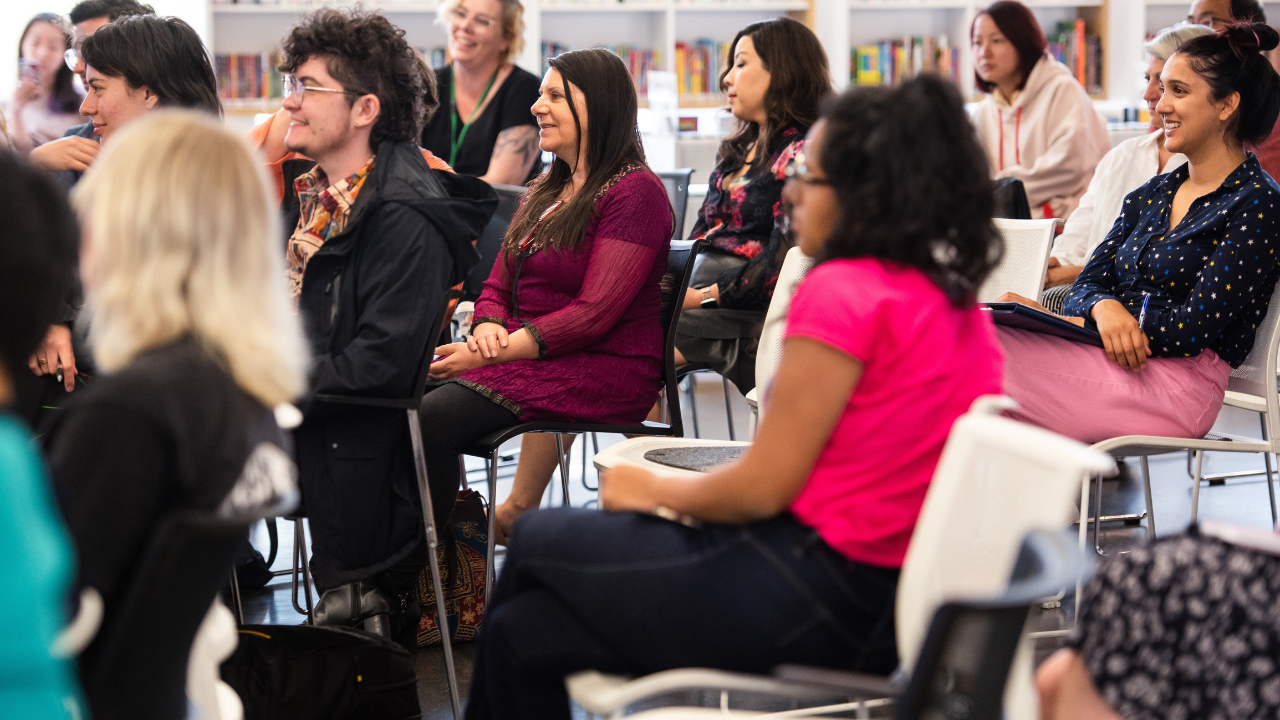Here is a Q&A with digital innovator, Emily Craven:
Who should focus their professional development in interactivity and digital stories?
Teachers, educators and anyone who wants to engage with children and young adults. The youth of today are immersed in digital culture, social media, video, audio and images captivating their attention and driving their imagination. This has born a generation of young people who love stories but hate to read. I teach about integrating reading and writing with the digital mediums that students love, creating a happy medium that engages as well as educates, prompting students to extend their stories beyond the page.
What exactly does interactivity mean and why should it be incorporated into the classroom?
In terms of storytelling, interactivity is when a reader must interact or perform some action for the story to continue or a reader’s actions or choices affects the direction of a story and how it ends.
Interactivity is not only important in classrooms but important for learning in general. Interactivity promotes an ‘active’ state of learning rather than a ‘passive’ state of learning, allowing readers or participants to retain more information and grasp concepts more easily by ‘doing’, ‘seeing’, ‘hearing’ and reading. The youth of today are more connected, distracted, and used to flashy, brightly coloured media. Printed books are so far removed from this reality there is no wonder there is a current disconnect between books, reading and youth. Tools incorporating transmedia and interactivity offer new and exciting possibilities for how students can construct and understand narrative while encouraging and enhancing creativity and communication. There are ways you can construct these type of experiences for your students without being a technical whiz.
Why is it important for teachers and people who work in education to increase their knowledge of digital projects and concepts?
One of the major motivations in schools today is creating lessons that promote and encourage creative, critical and divergent thinking. As society has changed across the decades so too have the ways we learn and the techniques and technologies we learn with. The methods we use to teach creative thinking when I was a student ten years ago, do not apply to the mindset of students today. Technologies I slowly grew into as a young adult, are accepted norms at birth for these children.
Students these days interact with digital devices rather than pen and paper, watch movies on screens the size of business cards and interact through photos and text rather than phone conversations. In this digital age writers young and old don’t have to stick with words in a book to tell their story, they can use social media, video, audio and images to tell a tale with a whole lot more oomph than a regular book. The potential for social media and mixed format books to tell ‘relevant’ modern day stories for a young adult audience is exciting and overwhelming. The advance of new technologies such as e-books and QR codes continue to open portals for powerful storytelling. This technology is what captures a young person’s attention, it is the normal way of communicating ideas, and if our teaching is not up to this standard the brain files our lesson as ‘irrelevant’ and moves on.
What are a few tips that you can share that teachers can start to implement into their classrooms?
The way you can start introducing interactivity into your classroom can be very simple. Start off with just two mediums, written story and video, and set the stories in the modern world initially.
Get each student to write a 3-5 page story that is set in the modern world with at least 3-4 characters in it. They would write this like any normal story – it must have a beginning, middle, end. There must be a conflict that has to be resolved. The characters must contribute in some sort of meaningful way to the main character’s story. Encourage them to reference the technology they use, have them describe the background of characters, the way they move and speak, the things that interest them, the places they go when the main character isn’t with them.
Then gather the students into groups of 3-4 and give them one of the stories not written by them. They have to pick one of the minor characters in the story and make two videos from that character’s point of view – either exploring their background, their life, or their take on the events in the written story. Get them to use the clues about how the character speaks, their hobbies etc from the original written story to bring the character to life in their videos. They can do it like a mini-play, or a video diary entry, or maybe a news broadcast, it’s up to them.
Then pick one or two stories to share with the whole class, reading the story out loud and playing the videos at the right moment so the students get an idea of what can be achieved when you put the two together.
Another, simpler exercise is to take your students to a stimulating location, either because of the variety of people or the landscape and get them to write a story set in the place they are sitting. The story can be fantasy, crime, modern, comedy, spy story, whatever they like as long as it is set in that place. Then read some of the stories out loud while in that location, allowing students to be in the location where the story is happening.
What should they avoid?
Just because you can bounce a story from book, to website, to social media, to video, back to a book, doesn’t mean you should! Some stories can be told better in one medium than another. If using video doesn’t really suit the story – for example a fantasy novel – then don’t use it, use something that does fit, like an audio of the music made by elves. You can’t just make a story using words and video because it’s cool – the story needs to suit the medium, it needs to communicate something significant, and it needs to have what most good stories have – compelling characters that yearn, struggle, triumph or face defeat. That is where the creative and divergent thinking comes in for the student. Their stories have to say something.
Anything else? Eg success stories, statistics, future trends, case studies
If anyone wants to see how interactivity and transmedia has been used to great effect they should check out the Inanimate Alice project (http://www.inanimatealice.com/). This whole site, including the story, and educational aids, is free and is a fantastic example of interactivity and transmedia. The project does show you how effective this type of storytelling and learning tool can be used in your classroom.
Emily Craven is an author of non-fiction, fantasy and YA fiction. In 2011-2012 she undertook a 12 month writing mentorship with world renowned fantasy author Isobelle Carmody, for her YA fantasy novel, Priori-The Power Within. She blogs and presents for If:Book Australia, Meanland, SAWC and the Australian Society of Authors on the future of digital publishing, e-book marketing, transmedia/interactivity and the reader/author connection. Her latest YA comedy novel, The Grand Adventures of Madeline Cain, is set in Facebook and is available from Amazon, Kobo and Bkclb.







